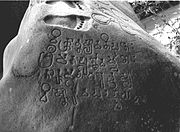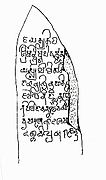Pallava script
| Pallava script | |
|---|---|
 'Pallava' in Pallava script | |
| Script type | |
Time period | 4th century CE to 8th century CE[1] |
| Direction | Left-to-right |
| Languages | Tamil,Old Khmer,Old Malay,Burmese,Thai,Sri Lankan Sinhala,Lao,Mon,Balinese,etc. |
| Related scripts | |
Parent systems | |
Child systems | Tamil,Grantha,Mon-Burmese,Khmer,Cham,Kawi |
Sister systems | Vatteluttu |
| Brahmic scripts |
|---|
| TheBrahmi scriptand its descendants |
ThePallava scriptorPallava Granthais aBrahmic scriptnamed after thePallava dynastyofSouthern India(Tamilakam) and is attested to since the 4th century CE. In India, the Pallava script evolved fromTamil-Brahmi.[2]TheGrantha scriptoriginated from the Pallava script.[3]Pallava alsospread to Southeast Asiaand evolved into scripts such asBalinese,[4]Baybayin,[5]Javanese,[6]Kawi,[7]Khmer,[8]Lanna,[9]Lao,[10]Mon–Burmese,[11]New Tai Lue,[12]Sundanese,[13]andThai.[14]
Epigrapher Arlo Griffiths argues that the name of the script is misleading as not all of the relevant scripts referred to have a connection with the Pallava dynasty. He instead advocates that these scripts be calledLate Southern Brāhmīscripts.[1]
History
[edit]During the rule ofPallavas,the script accompanied priests, monks, scholars, and traders intoSoutheast Asia.Pallavas developed the Pallava script based on theTamil-Brahmi.The main characteristics of the newer script are aesthetically matched and fuller consonant glyphs. Similar to Pallava script, also visible in the writing systems of Chalukya,[15]Kadamba, and Vengi at the time of Ikshvakus. Brahmi's design was slightly different from the scripts of Cholas, Pandyas, and Cheras. Pallava script was the first significant development of Brahmi in India, combining rounded and rectangular strokes and adding typographical effects, and was suitable for civic and religious inscriptions.Kadamba-Pallava script[16]evolved into early forms ofKannada and Telugu scripts.Glyphs become more rounded and incorporate loops because of writing upon leaves and paper.[16]
The script is not yet a part ofUnicodebut proposals have been made to include it. In 2018, Anshuman Pandey made a proposal.[17]
Characteristics
[edit]The form shown here is based on examples from the 7th century CE. Letters labeled * have uncertain sound value, as they have little occurrence in Southeast Asia.
Consonants
[edit]Each consonant has an inherent /a/, which will be sounded if no vowel sign is attached. If two consonants follow one another without intervening vowel, the second consonant is made into a subscript form, and attached below the first.
| ka | kha | ga | gha | nga |
|---|---|---|---|---|
| ca | cha | ja | jha* | nya |
| ṭa | ṭha* | ḍa | ḍha* | ṇa |
| ta | tha | da | dha | na |
| pa | pha | ba | bha | ma |
| ya | ra | la | va | |
| śa | ṣa | sa | ha | |
Independent Vowels
[edit]| a | ā | i | ī | u | e | o | ai* | au* |
|---|---|---|---|---|---|---|---|---|
Examples
[edit]-
Kadamba-Pallava script
-
TheCiaruteun inscription,a 5th-century Pallava stone inscription discovered inIndonesia
-
One of the oldest inscriptions discovered inIndonesia,theYūpa inscriptionsof KingMulavarman,king ofKutai Martadipurawritten in the4th century AD
Unicode
[edit]A proposal to encode the script inUnicodewas submitted in 2018.[17]
References
[edit]- ^abGriffiths, Arlo (2014). "53-57".LOST KINGDOMS: Hindu-Buddhist Sculpture of Early Southeast Asia.New York: The Metropolitan Museum of Art.ISBN9781588395245.
- ^Salomon, Richard (1998).Indian Epigraphy.p. 40.
- ^"Grantha alphabet".Retrieved13 September2018.
- ^"Balinese alphabet".Retrieved13 July2019.
- ^"Tagalog".Retrieved13 September2018.
- ^"Javanese alphabet".Retrieved13 September2018.
- ^"Kawi alphabet".Retrieved13 September2018.
- ^"Khmer".Retrieved13 September2018.
- ^"Lanna alphabet".Retrieved13 September2018.
- ^"Lao".Retrieved13 September2018.
- ^"Mon".Retrieved13 September2018.
- ^"New Tai Lue script".Retrieved13 September2018.
- ^"Sundanese".Retrieved13 September2018.
- ^"Thai".Retrieved13 September2018.
- ^http://www.skyknowledge.com/burnell-plate4.gif[bare URL image file]
- ^ab"Pallava script".Skyknowledge.com. 2014-02-02.Retrieved2014-03-13.
- ^abPandey, Anshuman. (2018).Preliminary proposal to encode Pallava in Unicode.
Bibliography
[edit]- Sivaramamurti, C,Indian Epigraphy and South Indian Scripts.Bulletin of the Madras Government Museum. Chennai 1999
External links
[edit] Media related toPallava scriptat Wikimedia Commons
Media related toPallava scriptat Wikimedia Commons




